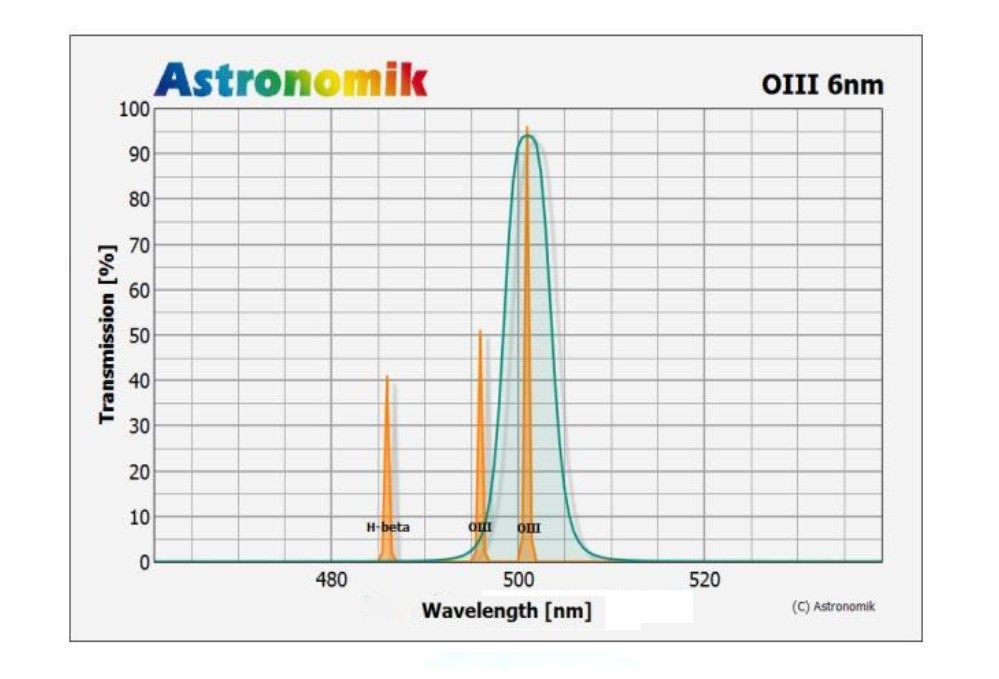
ASTRONOMIK
The Astronomik [O III] CCD filter is a super-narrow band emission line filter for CCD photography from observation sites with heavy light pollution and from dark sites as well.
Διαθέσιμο, συνήθως σε 5-14 μέρες

Astronomik O III CCD Filter, 6 nm FWHM, 1.25" (M28.5)
The Astronomik [O III] CCD filter is a super-narrow band emission line filter for CCD photography from observation sites with heavy light pollution and from dark sites as well.
The contrast between an object glowing at 501 nm and the background is increased enormously!
Due to the combination of the narrow bandwidth of 6 nm and the high transmission of typically 96%, the filter gives you an enormous contrast boost, as all unwanted light is blocked from UV up to the IR. This results in an extremely dark background.
The FWHM of 6 nm is matched to give you optimal performance with CCD and CMOS sensors with a very low dark current! The 6 nm filter is the best choice if you are observing from a heavily light polluted site or if you are imaging faint objects in starcrowded regions of the Milky Way.
Due to the new MFR coating technique you may use one single filter on all instruments up to f/4 without a significant reduction in performance.
Imaging with narrow band emission line filters
If you have to observe from light polluted sites (like most of us ...), imaging with narrow-band emission line filters is the best way to take great images, as all kind of light pollution can be blocked very effective! Normaly an H-alpha filter should be your first step into this amazing field of astrophotography! With a narrow band H-alpha filter you will be able to take deep and contrasty images even wih very heavy light pollution or with the full moon high up in the sky! If you look at other astrophotos, an H-alpha is the best choice for all nebulas glowing red! An [O III] filter expands your imaging possibilities, as you are able to image all greenish/blueish structures. Planetary nebulas and star forming regions are great targets! The [S II] filters completes your HSO-set of filters. With these three filters you are able to process your images like the ones from the Hubble space telescope!
The h-beta filter is not available in a 6 nm version, as this filter has nearly no meaningfull application. it is better to use the 6 nm H-alpha filter.
Operation of the filter:
The filter blocks all unwanted light from artifical light-pollution, natural airglow and moonlight. Especially light from high- and low-pressure sodium and mercury lights and all lines of natural airglow are 100% blocked. The filter increases the contrast between the sky-background and objects glowing at the [O III] line at 501 nm.
Other uses:
Using the OIII-CCD filter together with H-alpha-CCD and SII-CCD filters you make produce false-color emission line images (HSO) in the same way as the Hubble-Space telescope. This is possible even from heavyly light polluted sites!
Alternatives:
The lower priced 12 nm filters are the right choice for you if you own a typical DSLR or a CCD camera with a high dark current! The 12 nm filters should be the fist choice for cameras with an integrated guiding sensor, as you will have about twice as much stars compared to the 6 nm filter.
New protective ring!
Since spring 2015, some of the unmounted filters are delivered with a thin, undisturbing protective ring. This reduces the risk of reflections, mechanical stress or damage.
The edge under the ring is blackened.
The thickness of approx. 3 mm allows for using in all filter wheels for the corresponding filter size. O-rings or similar accessories, which are usually used for reducing tensions in he filter glass, cannot be used together with the ring, but are also not necessary anymore.
Filter transmission curve:
